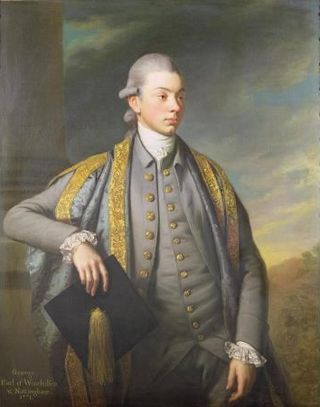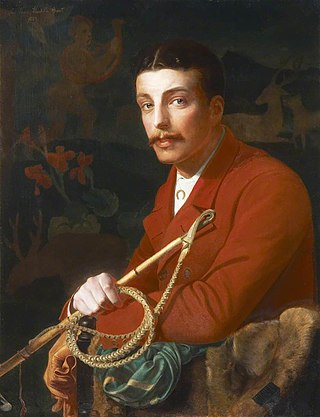
Baron Hesketh, of Hesketh in the County Palatine of Lancaster, is a title in the Peerage of the United Kingdom. It was created in 1935 for Sir Thomas Fermor-Hesketh, 8th Baronet, who had previously briefly represented Enfield in the House of Commons as a Conservative. As of 2010 the titles are held by his grandson, the third Baron, who succeeded his father in 1955. Lord Hesketh held junior ministerial positions in the Conservative administrations of Margaret Thatcher and John Major. However, he lost his seat in the House of Lords after the House of Lords Act 1999 removed the automatic right of hereditary peers to sit in the upper chamber of Parliament.

Baron Jeffreys is a title that has been created twice, once in the Peerage of England and once in the Peerage of the United Kingdom. The first creation came in the Peerage of England on 16 May 1685 when the lawyer and later Lord Chancellor, Sir George Jeffreys, 1st Baronet, was made Baron Jeffreys, of Wem. He had already been created a Baronet, of Bulstrode in the County of Buckingham, in the Baronetage of England in 1681. The titles became extinct on the death of his son, the second Baron, in 1702, who had no male heir: his daughter, the writer Henrietta Fermor, married the 1st Earl of Pomfret. The estates passed to Jeffreys' widow, Lady Charlotte Herbert, who later remarried as Viscountess Windsor.

Earl of Pomfret was a title in the Peerage of Great Britain created in 1721 for Thomas Fermor, 2nd Baron Leominster. The title became extinct upon the death of the fifth earl in 1867.

Easton Neston is a large grade I listed country house in the parish of Easton Neston near Towcester in Northamptonshire, England. It was built by William Fermor, 1st Baron Leominster (1648–1711), in the Baroque style to the design of the architect Nicholas Hawksmoor.

George Finch, 9th Earl of Winchilsea, was an English peer, army officer and cricketer who was an important figure in the history of cricket. His main contributions to the game were patronage and organisation but Winchilsea, an amateur, was also a very keen player. Finch served with the 87th Foot at the time of the American Revolutionary War from its formation in 1779 to its disbanding in 1783, with the temporary ranks of major and lieutenant-colonel. Finch was the first president of the Royal Institution, and it was through his influence that it received the endorsement of King George III.
Fermor is a surname, a variant of Farmer. Notable people with the surname include:

Lady Charlotte Finch was a British royal governess. She was governess to the children of King George III and Queen Charlotte for over thirty years, holding the position from 1762 to 1793. Her parents were courtiers Thomas Fermor, 1st Earl of Pomfret, and Henrietta Louisa Jeffreys. The couple were educated and frequently travelled with their growing brood of children to the continent. Charlotte, like her sisters, was well educated; in 1746, she married the Hon. William Finch and had issue including George Finch, 9th Earl of Winchilsea.

Sir Thomas George Fermor-Hesketh, 7th Baronet was a British baronet and soldier.
Sir Thomas George Fermor-Hesketh, 5th Baronet was an English Conservative politician who sat in the House of Commons from 1862 to 1872.

Henrietta Louisa Fermor, Countess of Pomfret, was an English letter writer.
General Thomas William Fermor, 4th Earl of Pomfret FRS, styled The Honourable Thomas Fermor until 1830, was an officer in the British Army who fought in the French Revolutionary and Napoleonic Wars.

William Fermor, 1st Baron Leominster, styled Sir William Fermor, 2nd Baronet from 1661 to 1692, was an English politician and peer.

Thomas Dawson, 1st Viscount Cremorne was an Irish landowner and politician from County Monaghan.

Thomas Fermor, 1st Earl of Pomfret was an English peer and courtier. He was the only son of William Fermor, 1st Baron Leominster by his third wife Lady Sophia Osborne. He succeeded to his father's barony on his death in 1711 as 2nd Baron Leominster. The Earldom of Pomfret was created for him on 27 December 1721, named after Pontefract in Yorkshire.

George Fermor, 2nd Earl of Pomfret (1722–1785), styled Viscount Leominster or Lempster until 1753, of Easton Neston house, Northamptonshire was Earl of Pomfret in the Peerage of Great Britain.

George Fermor, 3rd Earl of Pomfret was the third holder of the title of Earl of Pomfret in the Peerage of Great Britain.

George William Richard Fermor, 5th Earl of Pomfret was an English peer.

Peter Denys was a British drawing master, later patron of the arts and landowner.












